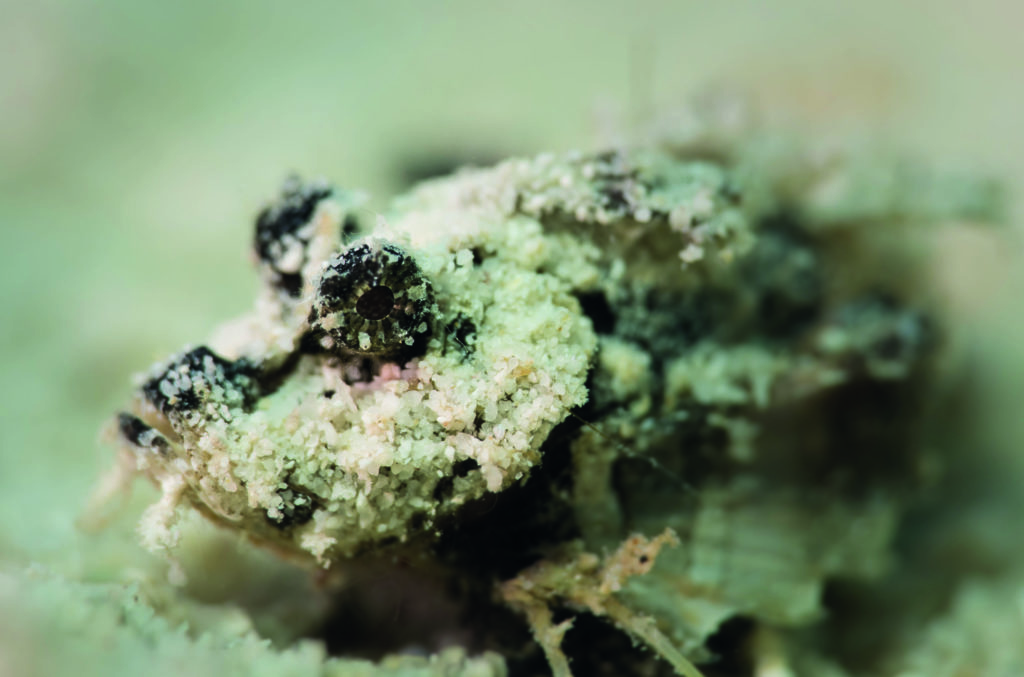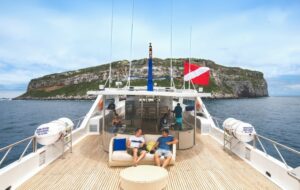Above and beyond
Paul ‘Duxy’ Duxfield explains how to get topside dive-related images, and then goes into detail about getting macro images that rise above simple fish ID images
I wanted to write an article this month about firstly those pictures that fall outside of regular underwater pictures but are great examples of shots that illustrate our hobby so well, by looking at some shots taken on the surface, and I will give a rundown of the way I’ve achieved them.
And then I will look at moving your macro pictures beyond straightforward fish ID shots to macro pictures that are a little bit different, so as to mix things up a bit.
So, kicking off, literally, I’m going to show you how to achieve that classic type of picture of a diver making a giant-stride entry into the water, but with a twist, so we will look at upping the drama and doing it when it’s lower light, and using your strobes to light the diver up and freeze the action.
Striding out
Technically, this sort of picture presents a few issues, but you’ve also got to think about some practical considerations.
Time of day – I like to shoot these pictures at dusk or dawn, and to be honest you’ll find it much easier to get willing models in the early evening I’ve found than first thing in the morning. It’s best just before a night or dusk dive with enough light in the darkening sky, but not so dramatic if it’s pitch black. Slide into the water and try not to get your dome port splashed with water droplets, ideally getting your rig handed down to you, keeping it high. Inflate your BCD to the max to help in this. Prepare your scene. Where is the sun going down (or coming up?) and visualise the image without a diver in it to sort out your backdrop.
I like to get these shots as unposed as possible, so timing is critical. Of course, you could get your buddy to repeat the procedure, but it’s a pain in the behind bothering people to keep getting in and out, and try as they might, they tend to act up to the camera.
Also, once you’ve had a few giant strides nearby you, your dome will be covered in water splashes.
So my exposure settings and flash output needs to be sorted to get it right first time and one time only ideally. I do this by taking a test shot of the scene sans diver, adjusting shutter speed and aperture, to give a nice dramatic sunset, at the same time I will focus on the ladders usually, and then lock the focus, by switching into manual focus.
Locking focus is important, as sometimes there may be the odd drop of water on your dome port or fisheye wet lens, and the camera will focus on this instead, meaning an out-of-focus scene.
Your flash output needs to be adjusted to light the diver, and with my strobes, which are quite small, this means with the typical camera settings that I have set, the strobes will be almost at full power.
Managing the whole rig out and above the water line, with the strobes as high as you can realistically place them, is quite physically demanding too. So the larger the rig you have the quicker you’ll need to work, and another reason why I tend to do more of these shots now I have a mirrorless rig rather than a DSLR!
Boat/manta split
For the next shot, it’s all about being able to react quickly when the action happens. This was on my most-recent workshop out in Komodo, a place famous for its mantas. And I’ve always wanted a split shot with a manta and the boat in frame.
So when in these locations, I always make sure between the dives that my camera is good to go, and ready to grab with snorkel, mask and fins if we’re lucky enough to have these magnificent creatures pitch up literally out of the blue. To speed things up, I will detach my strobes between dives, as then me and the kit is much more streamlined while snorkelling.
I will pick as fast a shutter speed as is possible in the prevailing conditions, in this case I was able to shoot at 1/500 a second, and the aperture was around f8 at 200 ISO. It was a lovely sunny day though, so be prepared to compromise these settings if its poor light. If you are going to sacrifice something though, make it the ISO first, and increase this before you compromise the shutter speed. This should be your primary consideration above all else, as all bets are off if your picture is spoilt by subject or camera movement.
Focus is important too, so I made sure that the boat was nice and sharp by locking the focus on this beforehand, freeing me up to shoot away as the scene unfolded in front of me. I’ll also often frame by shooting from the hip, hoping that Lady Luck is being kind to me.
This time it paid off, but if I’m being fussy then I’d have preferred that the manta was facing me, but I’ll take it as a win until next time.
Ok, we’ve covered the above, what about the beyond? I’m talking about getting shots that are a little elevated beyond just a plain old fish ID picture. Don’t get me wrong I’m not being snobby about a plain shot of a creature in its surroundings. Nothing wrong with that, and I take plenty myself especially if it’s something I haven’t seen or shot previously.
However, if it’s almost a carbon copy of the same creature as in the boat’s fish identification book, then I’m keen to try and up the creative stakes a bit and picture it in a more-unusual way, injecting a bit of personality into the shot.
So first we’ll look at how to shoot a macro or close-up picture if you happen to have your fisheye lens attached first.
Damsel Guarding Eggs
I was at one of my favourite Red Sea dive sites, the Barge in Gubal and this place is covered in marine life big and small. So lens choice is often a difficult or easy decision depending on your mindset. My take on it is that it really doesn’t matter, if you go in armed with your macro, no problem you’ll have plenty of subjects to shoot. And if you have your fisheye lens on then you’ve loads of scenes available to you as well, so those of you with cameras that you can attach wet lenses to are particularly well served.
Back to the shot, grey damsels like these are everywhere and they are often to be found fiercely guarding a silvery patch of eggs. A damsel like this is only a couple of inches long at best, so it needs to be really close, in this case literally touching the front of my mini domed fisheye lens.
So once again, focus is important. The damsel is darting around really quickly, watching its reflection in the dome. And even with the latest autofocus systems, this is a challenge. So I used my finger to lock the focus at about an inch in front of the dome, set a very small aperture about f16 to give maximum depth of field, covering any minor errors. I used inward lighting close to the dome, and then instead of looking through the lens to frame I instead held the camera below me, and fired shots when I saw the damsel get within the focus range in front of the dome.
I tilted the camera slightly upwards to try and get some background and surface in the frame, and once again prayed to Lady Luck. This type of macro shot with a fisheye lens is called close focus wide angle, and means that a whole load of new subjects opens up to you if you’re regularly shooting with a fisheye lens.
Lucky Devil
In the sand around a lot of muck diving hotspots can be found a type of creature sometimes called a devil scorpionfish, they can give a nasty sting and are a great, if painful way to remind divers to stay off the sand, as they’re usually very well camouflaged. This one was perfectly blending into the sandy area around it, and was only in about 3m of water, so there was enough light to switch off my strobes and use the plentiful available light to picture it.
This meant I was able to pick a nice fast shutter speed to keep everything steady, the side effect which was I was able to use a very wide aperture so that I could have a very narrow band of focus with my macro lens attached, only focusing upon the creature’s eye, making the background less distracting while still showing that there is an animal hiding out in the sand.
Don’t be shy about switching off your strobes when you can with your macro lens, as it will allow you to produce pictures that are different from the norm. Folk can often get into a rut particularly shooting macro, sticking to the same old settings time after time, so if you’re somewhere shallow, and well lit, have a go and switch off your strobes to mix things up a bit.
Good Behaviour
Or bad if you’re the poor chromis caught in the chops of this hungry lizardfish! Keep an eye out for behavioral encounters. This may mean just spending a bit of time watching the goings on in a small patch of reef.
Lizardfish are a worldwide very common, but very photogenic creature. And they’re a voracious predator. So if there’s a few around and suitably sized prey, just watch and wait, and if you’re lucky like I was here, you’ll be rewarded with one taking a big mouthful. Once they’ve caught a poor victim in those tiny but jagged needle-like teeth, they will stick around and slowly gulp it down, allowing you time to get a few shots of this macabre example of nature! I was able to get a few examples from different angles, but this was my personal favourite.
Summing up
You don’t need to make many adjustments to your usual regime to make some of your shots stand out a little more from the rest on your memory card. Okay, some things may be more technically demanding like the topside pictures and the close focus wide angle, but often all it takes is to move your strobe a little and change up your angles. It’s a win win around as the more difficult to achieve shots will gain you experience, and learning new things will keep things fresh. Read more visit the our Scuba Diver Mag Website.
Duxy Escorted Trips
A great way to learn how to use new kit and develop your skills is on a dedicated trip. My escorted trips are for all and if you have a GoPro or compact, I can improve your skills and realise your full potential in an easy-going, relaxed environment. If you’re a more-experienced shooter, my itineraries and locations are carefully picked to be very photographically productive.
Duxy will be leading a Red Sea liveaboard in 2023 – book now.
Photographs by Paul Duxfield












